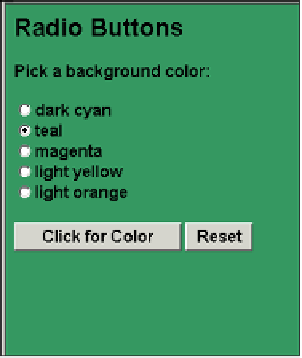HTML and CSS Reference
In-Depth Information
EXPLANATION
(
CONTINUED
)
3
If a radio button was checked, the
checked
property will return
true
.
4
If checked, the color of the background will be changed by assigning the value of
the radio button's
value
attribute to the
bgColor
property of the document.
5
The form is defined. It is named
formradio
.
6
The input type is a radio button, named
color
. Only one button can be selected
(see Figure 11.42). The value is a hexadecimal color code.
7
When the user clicks this button, the
onClick
event handler is triggered and the
handler function
changeBg()
is called, using the
this
keyword and the
form
object
as its argument.
Figure 11.42
Using radio buttons; only one can be checked.
Checkboxes.
Although radio buttons can only be checked once, a user can check as
many checkboxes as he or she wants. When a checkbox is clicked, it is on, and when it
is not, it is off.
Checkboxes are created with the HTML
<input type=“checkbox”>
and are represented
in JavaScript as a
checkbox
object with specific properties and methods used to manipu-
late the object. Each checkbox is a property of the
checkbox
object and assigned to an
array of elements in the order in which they are placed in the form. The
checked
property
of the
checkbox
object specifies whether a box was checked. It returns true if checked,
and false if not.
To reach a value in the checkbox list, you could use, for example,
docu-
ment.form1.check1
, where
form1
is the name of the form, and
check1
is the name of
the
checkbox
object. Figure 11.43 shows the JavaScript object hierarchy for the
checkbox
object. Tables 11.19 and 11.20 list the properties and methods of the
check-
box
object.



